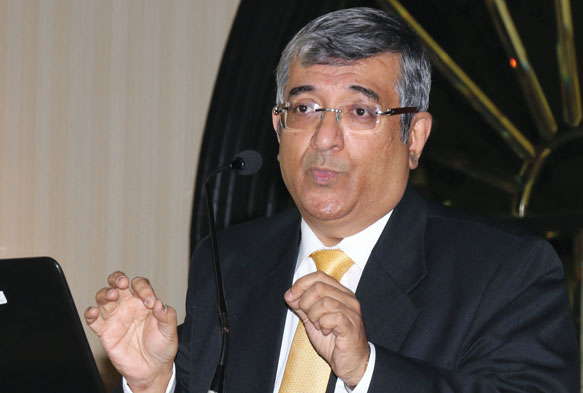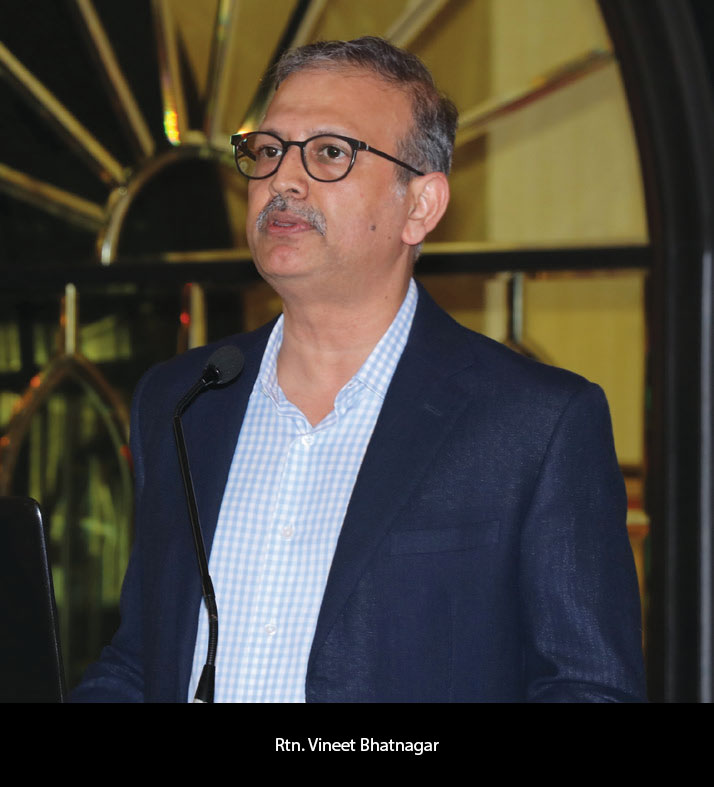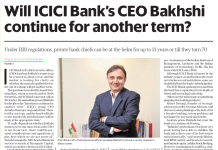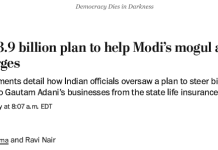HEMINDRA HAZARI
HOME / SPEAKER / GATEWAY / HEMINDRA HAZARI

HEMINDRA HAZARI
By admin Posted March 5, 2019 In Speaker / Gateway 0
SEBI-registered research analyst Hemindra Hazari brings a lot of fire power to his talks. The cannons he fired at last Tuesday’s meetings were honest, brutal and showed up the mess India’s finance companies have woven around themselves. And all this is despite various levels of monitoring by government and independent agencies. Therefore, Hemindra examined the meaning of corporate governance which, he said, has become such a fad these days, but whether it was just jargon or being practised remained to be seen.
“Corporate governance is about how corporates are monitored, managed and controlled,” he said, cautioning that corporate governance was not just about being compliant with the law. And yet, what it was about was a little vague, even for seasoned research analysts like himself, he admitted. He said, “Analysts like me have to see where companies are falling short or are they meeting the high standards which they flaunt and advertise?”
Needless to say, Hemindra – one of a small tribe of 55 to 60 Indian research analysts – knows the ins and outs of the Indian financial market. With his reveals into the actual workings of financial companies, Hemindra managed to keep Rotarians stuck to their seats 15 minutes over the usual allotted 20 minutes.
Hemindra has been part of the Indian capital market in the capacity of a research analyst and a specialist for banking and macro-economy. He has managerial experience of having established very profitable businesses and has also been a mentoring analyst. He has worked with prominent foreign and domestic capital market firms. In the course of his career, he has also interacted with prominent Indian companies and both foreign and domestic institutional investors. He is a regular guest on various business media channels and is respected for being a fierce and unafraid analyst and a commentator on a variety of topics. This has garnered him bouquets and brickbats aplenty. Hemindra revealed how banks which had revelled in the misery of others’ under his scrutiny did not quite take things so well
when it was their turn.
“The main four pillars of corporate governance,” said Hemindra, “are: accountability of the management, fairness and the kind of practices they practise not just vis-a-vis their shareholders but also clients, the wider society and the government, thirdly, how transparent are they about their practices and accounts and, finally, what is their responsibility?”
Hemindra’s keen interest in banks and financial companies comes from the recognition that these institutions are handling public funds. He said, “Banks are critical in any emerging or developed economy and if something goes wrong in one bank, it can spread to other banks, clogging up the entire payment system.
Hence, corporate governance in the banking and financial sector is important not only for shareholders but for depositors who are the greatest stakeholders, and for the broader economy. Any shortfall in corporate governance practices, in a bank, should be looked upon extremely seriously because it has a wider impact on society and for the entire economy.”
There is a system of checks and balances that has evolved to guard public interest. Hemindra calls them sentinels. Their job is to monitor, guard, protect and point out whether corporate governance practices are being followed by banks and corporates. They are:
- The Board of Directors and Independent Directors. Hemindra said, “Many people find it enviable to sit on the board of many corporates and it’s a very lucrative industry, especially for a lot of retired people.”
- “Auditors – everyone wants global funds for equity issues so you need globally recognised auditors to sign off. They are supposed to look at whether the numbers that these banks are producing are true and fair.”
- “Regulators like Reserve Bank of India (RBI) from a banks’ perspective. If you are a non-bank finance company, there is Securities and Exchange Board of India (SEBI) because companies are listed and SEBI also regulates an analyst like myself. Housing finances have the National Housing Board (NHB), and there is the Ministry of Corporate Affairs (MCA).”
- “There are Credit Rating Agencies which research and double-check all the financials audited by the auditors.”
- “There are numerous media business channels. India has three to four English business TV channels plus Hindi business channels plus digital platforms that specialise in business.”
- “Finally, there are banking research analysts like myself whose job it is to monitor and keep institutional or retail clients up to date on what banks and non-bank financial companies in their coverage are doing. In India, this community is about 55 to 60 hardcore dedicated banking analysts.”
IN SHORT, THERE ARE MULTIPLE EYES CONSTANTLY MONITORING WHAT IS GOING ON AND SO, ON PAPER, SAID HEMINDRA, CORPORATE GOVERNANCE SHOULD BE IN TOP CONDITION, BUT IT IS NOT SO.
Hemindra then referred to a financial debacle exposed last year where all the sentinels were in place and yet something went wrong. The magnitude of it sent shock-waves throughout the system, he said. The first sign of trouble was only when this company defaulted and got written about in the press.
Hemindra says he had never looked at that company because it was not listed. By the time he did look at it, the cat was out of the bag. When he began, Hemindra looked at the company’s annual report, openly available on their website. It was a horror story to beat all, he said. “Any ordinary analyst,” said Hemindra, “if he had just opened the report, and just looked at the first page of a summarised balance sheet of their consolidated position could have told you that it has been making losses for the last three years. Worse, for a bank and a financial company, we look at its capital-owned fund which is its net worth which is equity plus free reserves. All valuation of banks is done as a proportion or as a multiple of its book value.”
“Here, ever since consolidated accounts was mandated from FY2014, you could have seen straight away that this company had a negative equity. That its negative equity was Rs 752 cr in FY2014 and then it keeps increasing until in 2018, it becomes Rs 2,300 cr negative.”
Even if one made concessions for the fact that the latest FY ’18 may not have been available when people were looking at it but they could have looked at the period FY ’14 to FY ’17, said Hemindra. “How could credit rating agencies give this company the highest rating, a triple A, when their equity plus free reserves was negative? How is it that banks continued to lend to this company when the equity was negative? How is it that various debt mutual funds, in which you, as individual investors, had faith and to whom you gave your hard-earned savings, invested in this company? All of them had experienced analysts on their payroll. Despite this, either they did not bother to read the annual report which is the first thing to do when you analyse a company. Or, they somehow assumed that this was a sovereign company and that it had the backing of the Indian Government. That was the way it was marketed, that was the way it was perceived. But analysts don’t work on perception. Our job is to ignore all the marketing and dig deep into the numbers. Here, you didn’t even have to dig very deep to come across this.”
Hemindra said he began looking in to the annual report in early September and, by the end of the month, the entire situation was laid bare. “I said this company has been insolvent for the last four to five years. With such poor performance, I wanted to look at how the Board of Directors, such luminaries, were treating the executive management. When losses are mounting in a company, you would expect the CEO to be fired – juniors are fired for much less reason, for not meeting targets, for example. But does the same rule apply to the senior executives?”
Hemindra then revealed what he had found out. “Here, the CEO’s pay kept rising from Rs 7.3 cr in FY ’15 to Rs 11 cr in FY ’16 and which peaked at Rs 20 cr when he retired. And if you see the team, nothing happens to their pay. In some years, it falls nominally, a little, but absolutely no action was taken by the Board against key managerial personnel. Everybody seemed oblivious to what was going on and the focus seemed to be to constantly reward the CEO and his little coterie. This goes against all the principles of how you reward your senior management. The question arises: what was the Board really doing?”
“One of the most powerful subcommittees of the Board is the Nomination and Remunerations Committee (NRC) which reviews the performance of executives, determines salary hikes, determines how other Board Directors are performing their duties, should they be replaced and whether new Directors should be inducted. A professional NRC should have immediately seen the problem and taken decisions: sack the executive managers, get new managers, restructure the entire Board – because when losses were mounting the way they were, there is a serious problem. But, nothing was done. Worse, people were being rewarded for mounting losses.”
The second-most powerful committee of the Board, said Hemindra, was the Risk Management Committee (RMC). “This is where risks are monitored. In any bank or finance company, the RMC meets a minimum of three to four times a year. Just by reading the annual report, I detected that the Risk Management Committee had met only once since FY2015. This was disclosed in their Director’s Report,” said Hemindra, sounding outraged. “On what basis did the credit rating agencies give a triple A to this company? All this information is publicly available. I pointed out just a few things: that this company is insolvent and that its Risk Management Committee never met and senior management were getting rewarded for mismanagement. When the government took over this company, all three points were mentioned in their report. But I am not a genius; anyone who read the report could have told you this. You didn’t even have to do too much research. It could have been detected five years ago with publicly available information. But, nobody wanted to do it. In their mind, it was the government so you didn’t have to do analysis. Today you have a hundred thousand crore of NPAs which is ultimately going to eat into your pockets because you have invested in some debt mutual scheme which has invested in their paper.”
Hemindra fearlessly took digs at banks who had failed due to lack of good corporate governance and upon which he has done extensive research. Backed by skilful statistics and graphs’ presentation, Hemindra brought out some of the obvious fallacies. From the faults of the Boards of Directors to loopholes in the financial policies to the failures of the Risk Management Committee to the role and negligence of credit rating agencies – no one was spared.















